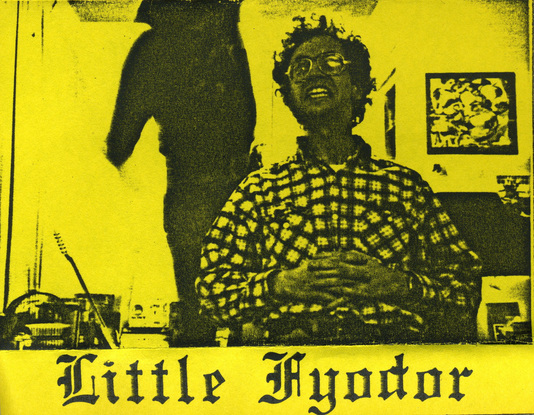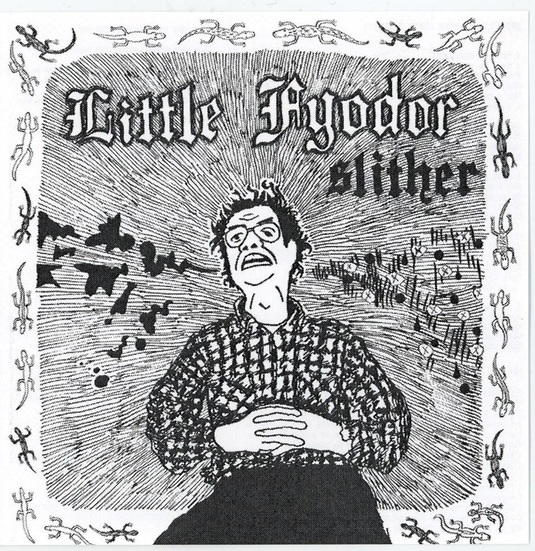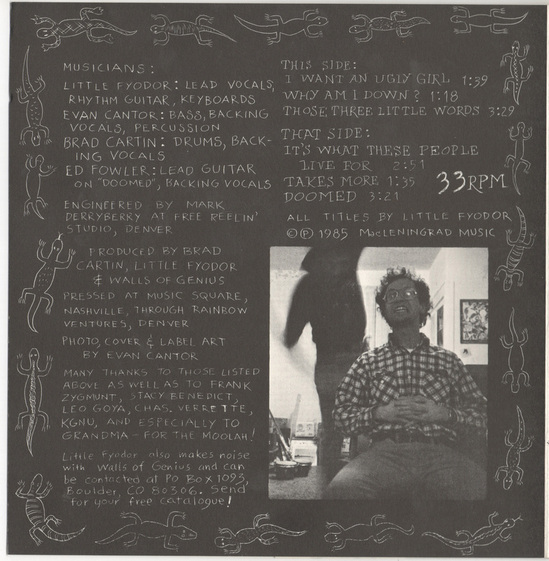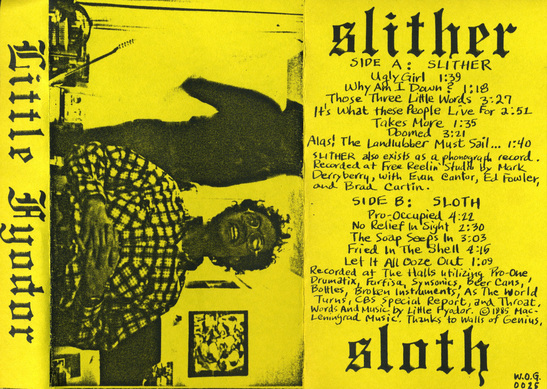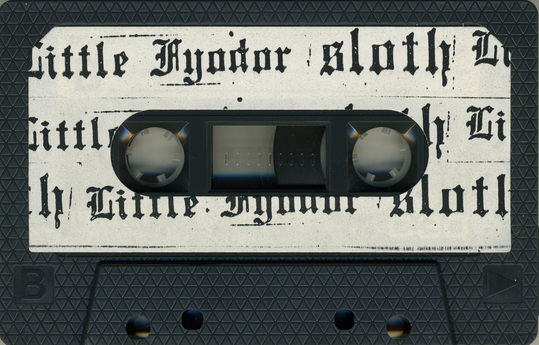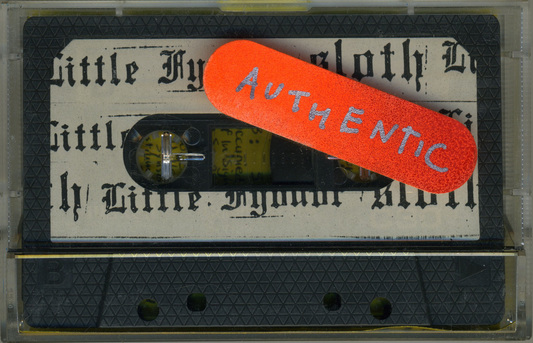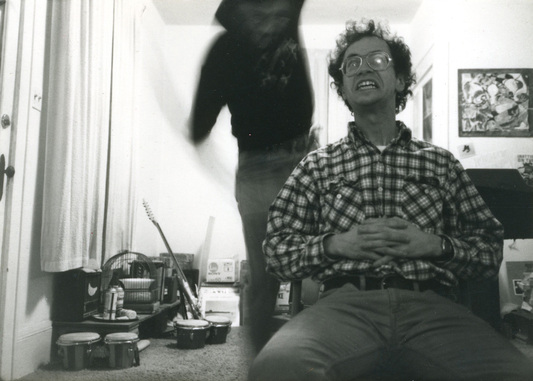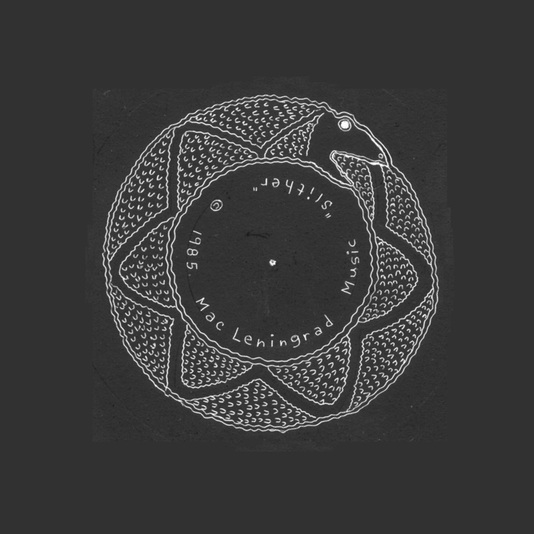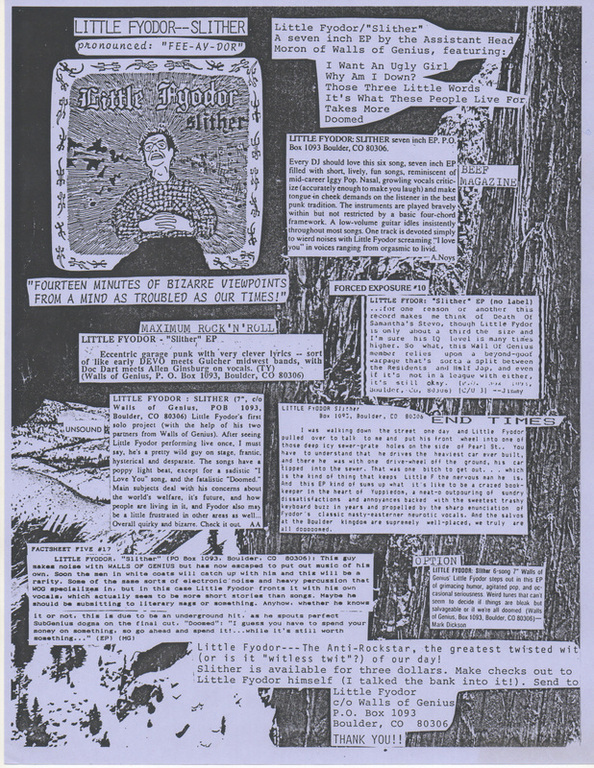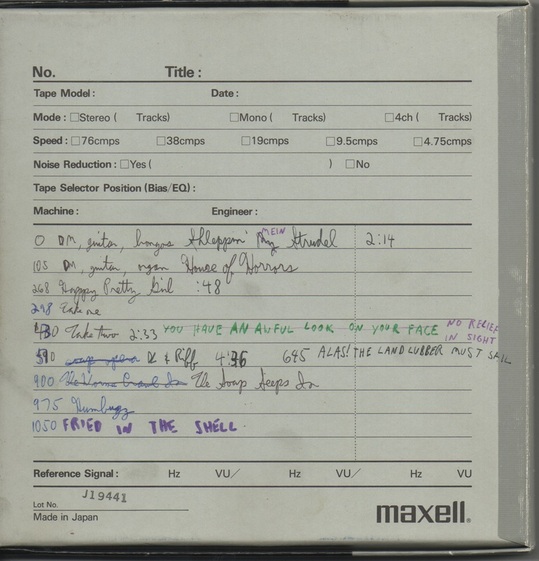WoG 0025 - Little Fyodor - Slither/Sloth
1985
Little Fyodor:
Slither was really the start of my solo “career”. It was released on the Walls Of Genius label, as Slither/Sloth, but it was really the start of my solo thing. Though I had actually attempted starting that before WoG even started. It was Little Fyodor songs that were the first things I recorded on Evan’s equipment shortly after we both moved to Colorado in 1981. It was really my first musical ambition, at least since first going through the motions in a typical covers band setting in Junior High, to write and perform (just cause I didn’t think anyone else would wanna perform them) my punk rock songs of alienation. Written songs given the full pop song focus and polish (well, polished up to a point and to the degree that I could!). The exact opposite in many ways from WoG. Almost the only similarity being the involvement of me, and, well, I can’t help being me, so whatever I do will be me. This is what I’d most wanted to do since I first started writing songs in Virginia before even moving to Colorado. And it was to record these songs that I helped Evan with the rent at Natasha’s place in Eldorado Springs. But then I got sidetracked by WoG.
Speaking of what I “most wanted to do” is a weird thing in this context cause, in fact, WoG was actually a lot more fun, in a lot of ways, at least. You didn’t have to worry about getting things “right” with WoG. No multiple takes, no “Is this the best it can be? Is this how I want it to be?” Fun was practically the point of WoG! And WoG was happening, while Little Fyodor solo was just a theory. So I ran with WoG, and had a great time of it, at least most of the time, enough of the time.
I must admit I don’t recall what exactly spurred me to finally take the dive into my solo world at the time that I did, but I can cite some factors. One was that bequeathment of money from my grandmother. I’ve mentioned this previously in the context of being able to buy some of the gear I did, such as the Farfisa organ and the first decent amp I had, the Roland Jazz Chorus 120. The total gift was a few thousand dollars, so it didn’t have to stop there. I may even have planned to use it for recording from the start, though I’m not sure.
Oh, recording, um, yeah. I loved me my Walls of Genius recording at the Hall of Genius. Just doing whatever came popping or pooping into the head. But I envisioned something different for my Little Fyodor songs, I wanted them recorded in a professional studio to make them sound like genuine pop/rock/punk songs. Like my pop/rock/punk heroes sounded like. The Ramones may sound raw, but they were still recorded in a professional studio! And I wanted it released on vinyl cause, well, alas, it made it seem more real, more bona fide… and more like my heroes!
Wait, I was telling you why I did this when I did. Or trying to, as much as I can. The money I got from my grandmother was definitely a factor as I even thanked her for it on the record’s liner notes! But either I received that money later than I’ve been thinking, and thus didn’t really use it to buy that gear as I think I did, or it was at least not an immediate cause. Another likely reason at the time was the troubles between me and Evan and the coming dissolution of WoG, though I also remember thinking that I could and wanted to do both the band and the solo thing concurrently for the foreseeable future, akin to what Lennon once suggested Harrison do when Georgie mentioned that he was writing too many songs to fit on Fabs records (do these things ever work out?). So it definitely wasn’t entirely just cause I thought there’d be no more WoG soon. But those difficulties may have helped motivate me to want to step out, to show both Evan and myself that I was my own person, my own artist. And maybe it was just time, it had been my dream after all, and the itch may have just crept up….
Evan Cantor:
It’s hard to say whether the title of this is “Slither” or “Slither/Sloth” or just “Little Fyodor” with side 1 called “Slither” and side 2 called “Sloth”. We were always interested in creating bewilderment in our audience, so this was likely left very ambiguous on purpose. This was Little Fyodor’s solo debut. Fyodor had inherited some money from his grandmother, so he financed “Slither” as a 45-rpm EP. The cassette release was “financed” by Walls of Genius. I put “financed” in quotes because we just barely generated enough revenue to keep buying cassettes, producing catalogs and distributing them.
Slither was really the start of my solo “career”. It was released on the Walls Of Genius label, as Slither/Sloth, but it was really the start of my solo thing. Though I had actually attempted starting that before WoG even started. It was Little Fyodor songs that were the first things I recorded on Evan’s equipment shortly after we both moved to Colorado in 1981. It was really my first musical ambition, at least since first going through the motions in a typical covers band setting in Junior High, to write and perform (just cause I didn’t think anyone else would wanna perform them) my punk rock songs of alienation. Written songs given the full pop song focus and polish (well, polished up to a point and to the degree that I could!). The exact opposite in many ways from WoG. Almost the only similarity being the involvement of me, and, well, I can’t help being me, so whatever I do will be me. This is what I’d most wanted to do since I first started writing songs in Virginia before even moving to Colorado. And it was to record these songs that I helped Evan with the rent at Natasha’s place in Eldorado Springs. But then I got sidetracked by WoG.
Speaking of what I “most wanted to do” is a weird thing in this context cause, in fact, WoG was actually a lot more fun, in a lot of ways, at least. You didn’t have to worry about getting things “right” with WoG. No multiple takes, no “Is this the best it can be? Is this how I want it to be?” Fun was practically the point of WoG! And WoG was happening, while Little Fyodor solo was just a theory. So I ran with WoG, and had a great time of it, at least most of the time, enough of the time.
I must admit I don’t recall what exactly spurred me to finally take the dive into my solo world at the time that I did, but I can cite some factors. One was that bequeathment of money from my grandmother. I’ve mentioned this previously in the context of being able to buy some of the gear I did, such as the Farfisa organ and the first decent amp I had, the Roland Jazz Chorus 120. The total gift was a few thousand dollars, so it didn’t have to stop there. I may even have planned to use it for recording from the start, though I’m not sure.
Oh, recording, um, yeah. I loved me my Walls of Genius recording at the Hall of Genius. Just doing whatever came popping or pooping into the head. But I envisioned something different for my Little Fyodor songs, I wanted them recorded in a professional studio to make them sound like genuine pop/rock/punk songs. Like my pop/rock/punk heroes sounded like. The Ramones may sound raw, but they were still recorded in a professional studio! And I wanted it released on vinyl cause, well, alas, it made it seem more real, more bona fide… and more like my heroes!
Wait, I was telling you why I did this when I did. Or trying to, as much as I can. The money I got from my grandmother was definitely a factor as I even thanked her for it on the record’s liner notes! But either I received that money later than I’ve been thinking, and thus didn’t really use it to buy that gear as I think I did, or it was at least not an immediate cause. Another likely reason at the time was the troubles between me and Evan and the coming dissolution of WoG, though I also remember thinking that I could and wanted to do both the band and the solo thing concurrently for the foreseeable future, akin to what Lennon once suggested Harrison do when Georgie mentioned that he was writing too many songs to fit on Fabs records (do these things ever work out?). So it definitely wasn’t entirely just cause I thought there’d be no more WoG soon. But those difficulties may have helped motivate me to want to step out, to show both Evan and myself that I was my own person, my own artist. And maybe it was just time, it had been my dream after all, and the itch may have just crept up….
Evan Cantor:
It’s hard to say whether the title of this is “Slither” or “Slither/Sloth” or just “Little Fyodor” with side 1 called “Slither” and side 2 called “Sloth”. We were always interested in creating bewilderment in our audience, so this was likely left very ambiguous on purpose. This was Little Fyodor’s solo debut. Fyodor had inherited some money from his grandmother, so he financed “Slither” as a 45-rpm EP. The cassette release was “financed” by Walls of Genius. I put “financed” in quotes because we just barely generated enough revenue to keep buying cassettes, producing catalogs and distributing them.
LF:
So I booked time at a studio way down, all the way down, unfathomably way down (that’s sarcasm) in Denver, a studio called Free Reelin’ that I’d heard that the Lepers (the band that Brad Carton was in) had used to make the couple of singles they’d put out. It was reputed to be affordable but good. It had eight whole tracks, woo-hoo! That seemed to be the cutting off point for “real” professional studios back then. I didn’t have to go far for musicians, drawing straight from the WoG pedigree. The parenthetically aforementioned Brad Carton said, “Perfect!” when I told him my songs were a cross between sixties rock and punk, and by the time of the record we had had a few goes at practicing them. And of course Evan was the ace bass player in the next room. He displayed outstanding dexterity on all manner of instruments, but he had his greatest amount of band experience on bass. He was gracious enough to learn and play my songs, even if perhaps while seething inside at me. I remember him scowling when he commenced learning the bass line I’d written for Ugly Girl and his expressing pronounced relief and surprise when he found triplets would work for a song that had been baffling and annoying him. I played rhythm guitar, which I had only had occasional occasion to do with WoG, and of course sang and overdubbed some keyboards. And Ed played lead guitar on Doomed! Evan told me Doomed sounded like WoG, probably cause of Ed’s lead played over repeated chords and a spoken rant, much like March of the Lost Wormsouls (Revisited), and he even seemed to suggest that it really should be a WoG song, but I stubbornly kept it LF, which turned out to be the right thing since there wasn’t a WoG much longer. “Those Three Little Words” was the next most WoG like in approach in that it was me overdubbing it all including using that sheet of plastic Frank Zygmunt had found for us. (Though I should add that it was probably a lot more “intense” than most anything I’d done with WoG!) Ed suggested we play “It’s What These People Live For” in WoG live shows and commented with some surprise that he’d never heard that one before. Well yeah, heh, guess I’d been keeping it in the back pocket…. We recorded it all in one day. Came back for mixing (and maybe a punch or two) but basically recorded everything in one day. I labor over this shit a whole lot more nowadays, but it came quick back then, and it came out pretty great too, I think. Damn good musicians and a youthful naivete and zeal and voice all helped!
I’m not going to address what the songs themselves were about or why I wrote them and that stuff. This is Little Fyodor material and I think I’ll wait for someone to take the kind of interest Hal has taken in WoG in Little Fyodor to go into all that….
EC:
I played the bass on the “Slither” tracks, in the Free Reelin’ studio, engineered by Mark Derryberry, along with Brad Carton on drums and Ed Fowler on lead-electric guitar. This was essentially the Walls of Genius house band, instructed by Little Fyodor.
So I booked time at a studio way down, all the way down, unfathomably way down (that’s sarcasm) in Denver, a studio called Free Reelin’ that I’d heard that the Lepers (the band that Brad Carton was in) had used to make the couple of singles they’d put out. It was reputed to be affordable but good. It had eight whole tracks, woo-hoo! That seemed to be the cutting off point for “real” professional studios back then. I didn’t have to go far for musicians, drawing straight from the WoG pedigree. The parenthetically aforementioned Brad Carton said, “Perfect!” when I told him my songs were a cross between sixties rock and punk, and by the time of the record we had had a few goes at practicing them. And of course Evan was the ace bass player in the next room. He displayed outstanding dexterity on all manner of instruments, but he had his greatest amount of band experience on bass. He was gracious enough to learn and play my songs, even if perhaps while seething inside at me. I remember him scowling when he commenced learning the bass line I’d written for Ugly Girl and his expressing pronounced relief and surprise when he found triplets would work for a song that had been baffling and annoying him. I played rhythm guitar, which I had only had occasional occasion to do with WoG, and of course sang and overdubbed some keyboards. And Ed played lead guitar on Doomed! Evan told me Doomed sounded like WoG, probably cause of Ed’s lead played over repeated chords and a spoken rant, much like March of the Lost Wormsouls (Revisited), and he even seemed to suggest that it really should be a WoG song, but I stubbornly kept it LF, which turned out to be the right thing since there wasn’t a WoG much longer. “Those Three Little Words” was the next most WoG like in approach in that it was me overdubbing it all including using that sheet of plastic Frank Zygmunt had found for us. (Though I should add that it was probably a lot more “intense” than most anything I’d done with WoG!) Ed suggested we play “It’s What These People Live For” in WoG live shows and commented with some surprise that he’d never heard that one before. Well yeah, heh, guess I’d been keeping it in the back pocket…. We recorded it all in one day. Came back for mixing (and maybe a punch or two) but basically recorded everything in one day. I labor over this shit a whole lot more nowadays, but it came quick back then, and it came out pretty great too, I think. Damn good musicians and a youthful naivete and zeal and voice all helped!
I’m not going to address what the songs themselves were about or why I wrote them and that stuff. This is Little Fyodor material and I think I’ll wait for someone to take the kind of interest Hal has taken in WoG in Little Fyodor to go into all that….
EC:
I played the bass on the “Slither” tracks, in the Free Reelin’ studio, engineered by Mark Derryberry, along with Brad Carton on drums and Ed Fowler on lead-electric guitar. This was essentially the Walls of Genius house band, instructed by Little Fyodor.
LF:
So anyway this is Slither we’re talking about so far, which I paid to have made into a 7 inch vinyl EP. It was almost enough to take up one side of a cassette, so one more short piece was used to complete that side and five more for the other side, all recorded the good ol’ Walls Of Genius way in the good ol’ Hall Of Genius. Together they made up Slither/Sloth, WoG 0025 in the catalog, followed only by the four Miracles and Son Of Madness before the work was done. I look at the reel box liner notes with the Sloth material on it, mostly after but also interspersed with my solo work on Do Not Write Beneath This Line, and I strain to remember how or if I approached it any differently from the other. Yeah, I think I knew it would be for my solo outing, and I was intent on showing that solo side of me, a little darker and more personal. First and last pieces of the Sloth side were just single track experiments on the synth and voice respectively. I was maybe emulating Evan by cutting up soap opera dialog for “The Soap Seeps In” (plus a little old lady’s kiss off to hijackers from a CBS Special Report at the end!) and maybe the Miracle by tapping on beer cans and bottles for “Fried In the Shell” (though I actually played a beer bottle and other found stuff for the first Pustones performance; Pots ‘n’ Pans Party anyone?). Brian Clark reissued “No Relief In Sight” on the Little Fyodor greatest hits CD he released on his Discriminate Audio label in 2005, in honor of the 20th anniversary of Slither, in fact, and made a video for it, even. Darren D. Danahy covered it for my tribute CD a few more years down this road. The title was inspired by a thunderstorm I got caught in during a solo backpack in the Indian Peaks. Keyboards, drum machines and doo-dads (plus bongos getting a doubling effect from the digital delay on “Relief”), all instrumental except for that non-verbal solo vocal excursion at the end, “Let it All Ooze Out”, heh….
EC:
“Sloth” was recorded back at the Hall o’Genius. The ‘Sloth” material could easily have been on any number of Walls of Genius titles, the ‘quirky instrumentals’ that Little Fyodor excelled at creating. These tracks represent a full range of both our interests, from pure electronic music (“Pre-Occupied”) to nothing but voice itself (“the Ooze”) and various destinations in-between. There is a collage piece with terrific dialogue from ‘As The World Turns’ (“The Soap Seeps In”). That piece ends with an arresting clip about somebody wishing that some other person was dead. As I was backing away from Walls of Genius at the time of this release, Fyodor had very likely been assembling the material on his own and it was available for release.
LF:
A few more notes on the material. “Alas! The Landlubber Must Sail” was me playing guitar over some programmed noise swells on my synthesizer that I hoped would sound like ocean waves. I thought the little guitar bit I played repeatedly sounded like an old sea shanty. I played my guitar through my cheap Fuzz-Wah distortion pedal. It was done at the Hall and not included on the Slither record, though it ended up on the Slither side of the cassette. I think it makes a nice coda for all the doom, especially in light of its title, which was something I very much felt about myself and figured probably applied to the whole of humanity as well (talking metaphorically here, people, metaphorically!). I faded both tracks up and down, but not at the same rate, I think the guitar went up first and down later, or maybe it was vice versa…? Pro-Occupied was a single track take on my Pro-One synthesizer. It was primarily composed, if you count compositions that only exist in your head. Maybe “planned out” is better? “Fried in the Shell” was my first foray into midi technology (let’s have another woo-hoo!) as it features my Drumatix drum machine and my Pro-One synthesizer linked up. Though everything else about the piece is very low tech. The title was something I thought up when Rumours Of Marriage was trying to figure out their band name before they had one, and Ed liked my idea, if no one else did. If you didn’t catch it already, “The Soap Seeps In” is based on an old tune with a similar name except about worms. The soap dialog all comes from one episode. I programmed the synthesizer to play the tune then manipulated it as it went. “Let It All Ooze Out” actually gets cut off before the end on most cassettes, including the one Hal used to transcribe the music online. If you get the CD-R version, you can hear the whole few more seconds. Back to Slither, Takes More includes grunting backing vocals from Evan, Brad and Ed, and maybe even by Mark Derryberry, the engineer (Mark runs a much more upscale studio nowadays!), which I think was Evan and Brad’s idea. You can hear Evan ending the piece with an ominous sounding breath. Evan also plays percussion on Doomed, using something he found at the studio, which, again, was entirely his idea…. I also remember Evan being very happy in the studio and dancing around to my Farfisa overdub on Ugly Girl. Brad or Ed said something like, “What, didn’t you expect it to sound good?” And Evan said, “I expected it to sound good, I didn’t expect it to sound THIS good!”
EC:
It’s an interesting collection in many ways, not the least being that “Slither” was so completely different from “Sloth”. Should the experimental avant-garde tunes been mixed “in” with the straight rock songs? That’s no more than a “what-if” proposition. In retrospect, I think Little Fyodor’s audience could appreciate both sides of his musical persona, even if, in subsequent years, he has more clearly focused on his rock-song side.
So anyway this is Slither we’re talking about so far, which I paid to have made into a 7 inch vinyl EP. It was almost enough to take up one side of a cassette, so one more short piece was used to complete that side and five more for the other side, all recorded the good ol’ Walls Of Genius way in the good ol’ Hall Of Genius. Together they made up Slither/Sloth, WoG 0025 in the catalog, followed only by the four Miracles and Son Of Madness before the work was done. I look at the reel box liner notes with the Sloth material on it, mostly after but also interspersed with my solo work on Do Not Write Beneath This Line, and I strain to remember how or if I approached it any differently from the other. Yeah, I think I knew it would be for my solo outing, and I was intent on showing that solo side of me, a little darker and more personal. First and last pieces of the Sloth side were just single track experiments on the synth and voice respectively. I was maybe emulating Evan by cutting up soap opera dialog for “The Soap Seeps In” (plus a little old lady’s kiss off to hijackers from a CBS Special Report at the end!) and maybe the Miracle by tapping on beer cans and bottles for “Fried In the Shell” (though I actually played a beer bottle and other found stuff for the first Pustones performance; Pots ‘n’ Pans Party anyone?). Brian Clark reissued “No Relief In Sight” on the Little Fyodor greatest hits CD he released on his Discriminate Audio label in 2005, in honor of the 20th anniversary of Slither, in fact, and made a video for it, even. Darren D. Danahy covered it for my tribute CD a few more years down this road. The title was inspired by a thunderstorm I got caught in during a solo backpack in the Indian Peaks. Keyboards, drum machines and doo-dads (plus bongos getting a doubling effect from the digital delay on “Relief”), all instrumental except for that non-verbal solo vocal excursion at the end, “Let it All Ooze Out”, heh….
EC:
“Sloth” was recorded back at the Hall o’Genius. The ‘Sloth” material could easily have been on any number of Walls of Genius titles, the ‘quirky instrumentals’ that Little Fyodor excelled at creating. These tracks represent a full range of both our interests, from pure electronic music (“Pre-Occupied”) to nothing but voice itself (“the Ooze”) and various destinations in-between. There is a collage piece with terrific dialogue from ‘As The World Turns’ (“The Soap Seeps In”). That piece ends with an arresting clip about somebody wishing that some other person was dead. As I was backing away from Walls of Genius at the time of this release, Fyodor had very likely been assembling the material on his own and it was available for release.
LF:
A few more notes on the material. “Alas! The Landlubber Must Sail” was me playing guitar over some programmed noise swells on my synthesizer that I hoped would sound like ocean waves. I thought the little guitar bit I played repeatedly sounded like an old sea shanty. I played my guitar through my cheap Fuzz-Wah distortion pedal. It was done at the Hall and not included on the Slither record, though it ended up on the Slither side of the cassette. I think it makes a nice coda for all the doom, especially in light of its title, which was something I very much felt about myself and figured probably applied to the whole of humanity as well (talking metaphorically here, people, metaphorically!). I faded both tracks up and down, but not at the same rate, I think the guitar went up first and down later, or maybe it was vice versa…? Pro-Occupied was a single track take on my Pro-One synthesizer. It was primarily composed, if you count compositions that only exist in your head. Maybe “planned out” is better? “Fried in the Shell” was my first foray into midi technology (let’s have another woo-hoo!) as it features my Drumatix drum machine and my Pro-One synthesizer linked up. Though everything else about the piece is very low tech. The title was something I thought up when Rumours Of Marriage was trying to figure out their band name before they had one, and Ed liked my idea, if no one else did. If you didn’t catch it already, “The Soap Seeps In” is based on an old tune with a similar name except about worms. The soap dialog all comes from one episode. I programmed the synthesizer to play the tune then manipulated it as it went. “Let It All Ooze Out” actually gets cut off before the end on most cassettes, including the one Hal used to transcribe the music online. If you get the CD-R version, you can hear the whole few more seconds. Back to Slither, Takes More includes grunting backing vocals from Evan, Brad and Ed, and maybe even by Mark Derryberry, the engineer (Mark runs a much more upscale studio nowadays!), which I think was Evan and Brad’s idea. You can hear Evan ending the piece with an ominous sounding breath. Evan also plays percussion on Doomed, using something he found at the studio, which, again, was entirely his idea…. I also remember Evan being very happy in the studio and dancing around to my Farfisa overdub on Ugly Girl. Brad or Ed said something like, “What, didn’t you expect it to sound good?” And Evan said, “I expected it to sound good, I didn’t expect it to sound THIS good!”
EC:
It’s an interesting collection in many ways, not the least being that “Slither” was so completely different from “Sloth”. Should the experimental avant-garde tunes been mixed “in” with the straight rock songs? That’s no more than a “what-if” proposition. In retrospect, I think Little Fyodor’s audience could appreciate both sides of his musical persona, even if, in subsequent years, he has more clearly focused on his rock-song side.
Slither
Ugly Girl
Why Am I Down?
Those Three Little Words
It's What These People Live For
Takes More
Doomed
Alas! The Landlubber Must Sail...
SLITHER also exists as a phonograph record. Recorded at Free Reelin' Studio by Mark Derryberry, with Evan Cantor, Ed Fowler, and Brad Carton.
Ugly Girl
Why Am I Down?
Those Three Little Words
It's What These People Live For
Takes More
Doomed
Alas! The Landlubber Must Sail...
SLITHER also exists as a phonograph record. Recorded at Free Reelin' Studio by Mark Derryberry, with Evan Cantor, Ed Fowler, and Brad Carton.
Sloth
Pro-Occupied
No Relief In Sight
The Soap Seeps In
Fried In The Shell
Let It All Ooze Out
Recorded at The Halls utilizing Pro-One, Drumatix, Farfisa, Synsonics, Beer Cans, Bottles, Broken Instruments, As The World Turns, CBS Special Report, and Throat. Words And Music by Little Fyodor. © 1985 MacLeningrad Music. Thanks to Walls Of Genius.
Pro-Occupied
No Relief In Sight
The Soap Seeps In
Fried In The Shell
Let It All Ooze Out
Recorded at The Halls utilizing Pro-One, Drumatix, Farfisa, Synsonics, Beer Cans, Bottles, Broken Instruments, As The World Turns, CBS Special Report, and Throat. Words And Music by Little Fyodor. © 1985 MacLeningrad Music. Thanks to Walls Of Genius.
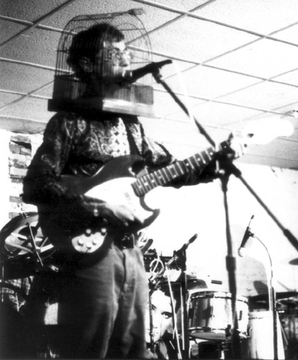
LF:
The Slither/Sloth photo of me was taken by Evan one evening at the Hall. Everyone liked it and me and Evan competed for taking credit! In addition to taking the photo, Evan also appears in it behind me, moving/jumping about. I guess he placed the camera on a delay. That’s my guitar on the bottom left along with a birdcage I once wore on my head during a Little Fyodor solo section during a WoG gig. In the upper right, we can see a magic marker (and/or pen and pencil?) drawing of Leo’s called “Love”.
Evan also did the rest of the design for both the cassette and the Slither record. For the latter, he drew a facsimile of my pose in that photo using pen and ink. Some of the design that depicted strange sounds coming out of my head was inspired by a splotch of ink that Evan accidentally dropped onto the original work which he then decided to incorporate into the design. My father complained that I’m better looking than I’m depicted in Evan’s rendering, which I’ve always suspected was a reflection of Evan venting some of his hostility towards me, which I think is cool! It’s punk, after all, I may as well be hated!
Evan utilized the art technique known as scratchboard for the backside liner notes and for the labels, a technique he would years later make a portion of his living off of when applied to things like flowers and mountain scenery. He reflected the name of the record by depicting lizards on the front and back covers and a snake eating its tail (and thus itself) on the label. All very cool shit! I had given him a plastic sleeve that was one of a bunch that I’d bought to put the folded artwork into (and the record in its sleeve into that), and he made the artwork to go right up to the very edge of the plastic – I only found out later that not all of the plastic sleeves were the same size and the one I gave Evan was one of the bigger ones, meaning that sometimes the artwork would stick a little ways out!
EC:
I designed the cover for Walls of Genius’ release of the cassette. The cover photo is something I set up in the Hall of Genius’ front room. We sat Fyodor on a chair and I had him grimace while I swirled around behind him to create a blurred effect, insinuating some kind of psychological instability. You can see Leo Goya’s original painting, “Love”, on the wall over Fyo’s shoulder and a guitar, which looks like a Fender of some kind, leaning against some stuff in the background. I set the camera on a timer, so I could run around behind Fyodor and do my swirling thing. The lettering is a kind of newspaper Gothic, like a New York Times banner, created from Letraset. The song list and credits were hand-inked by me with a Speedball India ink pen.
I also designed the artwork on the “Slither” 45-rpm EP. That was done with scratchboard. The record itself featured an Ouroboros image, a circular snake eating its own tail. The same photograph was featured on the sleeve, with my drawing of Little Fyodor (taken from the photo) on the front cover.
The Slither/Sloth photo of me was taken by Evan one evening at the Hall. Everyone liked it and me and Evan competed for taking credit! In addition to taking the photo, Evan also appears in it behind me, moving/jumping about. I guess he placed the camera on a delay. That’s my guitar on the bottom left along with a birdcage I once wore on my head during a Little Fyodor solo section during a WoG gig. In the upper right, we can see a magic marker (and/or pen and pencil?) drawing of Leo’s called “Love”.
Evan also did the rest of the design for both the cassette and the Slither record. For the latter, he drew a facsimile of my pose in that photo using pen and ink. Some of the design that depicted strange sounds coming out of my head was inspired by a splotch of ink that Evan accidentally dropped onto the original work which he then decided to incorporate into the design. My father complained that I’m better looking than I’m depicted in Evan’s rendering, which I’ve always suspected was a reflection of Evan venting some of his hostility towards me, which I think is cool! It’s punk, after all, I may as well be hated!
Evan utilized the art technique known as scratchboard for the backside liner notes and for the labels, a technique he would years later make a portion of his living off of when applied to things like flowers and mountain scenery. He reflected the name of the record by depicting lizards on the front and back covers and a snake eating its tail (and thus itself) on the label. All very cool shit! I had given him a plastic sleeve that was one of a bunch that I’d bought to put the folded artwork into (and the record in its sleeve into that), and he made the artwork to go right up to the very edge of the plastic – I only found out later that not all of the plastic sleeves were the same size and the one I gave Evan was one of the bigger ones, meaning that sometimes the artwork would stick a little ways out!
EC:
I designed the cover for Walls of Genius’ release of the cassette. The cover photo is something I set up in the Hall of Genius’ front room. We sat Fyodor on a chair and I had him grimace while I swirled around behind him to create a blurred effect, insinuating some kind of psychological instability. You can see Leo Goya’s original painting, “Love”, on the wall over Fyo’s shoulder and a guitar, which looks like a Fender of some kind, leaning against some stuff in the background. I set the camera on a timer, so I could run around behind Fyodor and do my swirling thing. The lettering is a kind of newspaper Gothic, like a New York Times banner, created from Letraset. The song list and credits were hand-inked by me with a Speedball India ink pen.
I also designed the artwork on the “Slither” 45-rpm EP. That was done with scratchboard. The record itself featured an Ouroboros image, a circular snake eating its own tail. The same photograph was featured on the sleeve, with my drawing of Little Fyodor (taken from the photo) on the front cover.
early Little Fyodor promo sheet, including reviews of the Slither EP.
